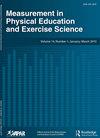儿童和青少年囊性纤维化患者加速度计的校准和交叉验证
IF 1.9
4区 教育学
Q2 EDUCATION & EDUCATIONAL RESEARCH
Measurement in Physical Education and Exercise Science
Pub Date : 2022-04-20
DOI:10.1080/1091367X.2022.2065919
引用次数: 3
摘要
囊性纤维化(CF)患者常用的分界点可能会对身体活动(PA)进行错误分类。本研究的目的是开发和交叉验证CF儿童和青少年的特定条件切割点。35名CF儿童和青少年(15名女孩;11.6±2.8岁)和28名对照组(16名女孩;12.2±2.7岁),在6次不同强度的日常活动中测量他们的能量消耗和三轴加速度。使用GENEActiv(双腕)和ActiGraph GT9X(双腕和右腰)加速度计提取欧几里得Norm - 1 (ENMO)和Mean Amplitude Deviation (MAD)。ROC曲线用于确定久坐时间(SED)、中度体力活动(MPA)和剧烈体力活动(VPA)的健康和cf特异性原始加速度切点。与对照组相比,ENMO (60.2-73.1 vs. 63.5-86.8 mg)和MAD (58.9-85.2 vs. 75.9-93.7 mg)的CF患者PA切割点普遍较低。这些切点之间的巨大差异支持了对特定疾病切点的需求。本文章由计算机程序翻译,如有差异,请以英文原文为准。
Calibration and Cross-validation of Accelerometry in Children and Adolescents with Cystic Fibrosis
ABSTRACT Commonly used cut-points may misclassify physical activity (PA) in people with cystic fibrosis (CF). The aim of this study was to develop and cross-validate condition-specific cut-points in children and adolescents with CF. Thirty-five children and adolescents with CF (15 girls; 11.6 ± 2.8 years) and 28 controls (16 girls; 12.2 ± 2.7 years), had their energy expenditure and triaxial acceleration measured during six daily activities of varying intensities. Euclidean Norm Minus One (ENMO) and Mean Amplitude Deviation (MAD) were extracted using both GENEActiv (both wrists) and ActiGraph GT9X (both wrists and right waist) accelerometers. ROC curves were used to determine healthy and CF-specific raw acceleration cut-points for sedentary time (SED), moderate physical activity (MPA) and vigorous physical activity (VPA). The PA cut-points were generally lower in CF compared to controls for both ENMO (60.2–73.1 vs. 63.5–86.8 mg) and MAD (58.9–85.2 vs. 75.9–93.7 mg). These substantial inter-cut-point differences support the need for disease-specific cut-points.
求助全文
通过发布文献求助,成功后即可免费获取论文全文。
去求助
来源期刊

Measurement in Physical Education and Exercise Science
Medicine-Orthopedics and Sports Medicine
CiteScore
4.20
自引率
33.30%
发文量
24
期刊介绍:
The scope of Measurement in Physical Education and Exercise Science (MPEES) covers original measurement research, special issues, and tutorials within six substantive disciplines of physical education and exercise science. Six of the seven sections of MPEES define the substantive disciplines within the purview of the original research to be published in the journal: Exercise Science, Physical Activity, Physical Education Pedagogy, Psychology, Research Methodology and Statistics, and Sport Management and Administration. The seventh section of MPEES, Tutorial and Teacher’s Toolbox, serves to provide an outlet for review and/or didactic manuscripts to be published in the journal. Special issues provide an avenue for a coherent set of manuscripts (e.g., four to five) to collectively focus in-depth on an important and timely measurement-related issue within the scope of MPEES. The primary aim of MPEES is to publish high-impact manuscripts, most of which will focus on original research, that fit within the scope of the journal.
 求助内容:
求助内容: 应助结果提醒方式:
应助结果提醒方式:


